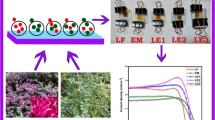Abstract
Dye-sensitized solar cells (DSSCs) are an environmentally friendly, easy-to-make, and cost-effective type of solar cell. However, its disadvantages are that it is not stable and is not at the desired level in terms of efficiency. These disadvantages are a major challenge for DSSCs to have a say in the solar cell industry. In this study, copper-quercetin complex was used as a sensitizer in dye-sensitized solar cells and the well-known N3 dye was used as a sensitizer in a reference cell for comparison purposes. TiO2 photoanodes coated with doctor-blade technique on ITO-coated glass were characterized by XRD and SEM. It was determined from the XRD results that dominant phase of the TiO2 photoanode was in the anatase phase and from the SEM images it was porous, spongy, and approximately 30-µm thickness. The electrochemical properties of the copper-quercetin complex were investigated by CV technique. From the cyclic voltammetry results, the EHOMO, ELUMO, and Eg values of the copper-quercetin complex were calculated as 5.02, 2.53, and 2.49 eV, respectively. We calculated power conversion efficiencies (η %) of copper-quercetin complex and N3 dye-sensitized DSSCs as 0.093 and 0.199, respectively, under the standard conditions of 1.5 AM (100 mW/cm2). Based on a proportional comparison with the best efficiency in DSSCs with N3 dye to date, we calculated that the efficiency of the DSSC designed with copper-quercetin complex would be around 5% under ideal conditions. In our study, it was examined in terms of stability, a second parameter that directly affects the performance of the cell. It was observed that the solar cell, in which we used copper-quercetin complex as a sensitizer, displayed an extremely stable structure in the measurements taken in weekly periods for 5 weeks.











Similar content being viewed by others
Research Data Policy and Data Availability
The authors acknowledge the journal’s Research Data Policy. The data that support the findings of this study are available from the corresponding author (Cihat Özaydın (cihat.ozaydin@batman.edu.tr)) upon reasonable request.
References
B. O’Regan, M. Grätzel, Nature 353, 737 (1991)
D. Wang, Y. Wu, H. Dong et al., Org. Electron. 14, 3297 (2013)
J.-B. Lopez, N.F. Holguin, J.C. Gonzalez, D.G. Mitnik, J. Photochem. Photobiol. A: Chem. 267, 1 (2013)
J. Warnan, L. Favereau, Y. Pellegrin et al., J. Photochem. Photobiol. A 226, 9 (2011)
E. Baranoff, J.H. Yum, I. Yung et al., Chem. Asian J. 5, 496 (2010)
S. Çakar, J. Power Sourc. 435, 226825 (2019)
S. Çakar, M. Özacar, J. Photochem. Photobiol. A 346, 512 (2017)
C. Barolo, Md. K. Nazeeruddin, S. Fantacci et al., Inorg. Chem. 45, 4642 (2006)
S.B. Bukhari, S. Memon, M.M. Tahir, M.I. Bhanger. Spectrochim. Acta Part A, 71, 1901 (2009)
I.K. Popoola, M.A. Gondal, J.M. AlGhamdi, T.F. Qahtan Nat/Sci. Rep, 8, 12864 (2018)
T. Kinoshita, J.T. Dy, S. Uchida et al., Nat. Photo. 7, 535 (2013)
K.I. Jang, E Honge, J.H. Kim Korean. J. Chem. Eng. 30, 620 (2013)
C. Özaydın, Ö. Güllü, O. Pakma et al., Mater. Res. Bull. 77, 115 (2016)
A.L. Fahrenbruch, R.H. Bude, Fundament. Solar Cells Acad. New York, 49, (1983)
M.M. El-Nahass, E.M. El-Menyawy, Mater. Sci. Eng., B 177, 145 (2012)
A. Shafiee, M.M. Salleh, M. Yahaya, Sains Malaysiana 40(2), 173 (2011)
J. Liu, X. Sun, Z. Li et al., J. Photochem. Photobiol. A: Chem. 294, 54 (2014)
O. Dayan, A.G. İmer, M. Tercan et al., J. Mol. Struct. 1238, 130464 (2021)
P. Singh, N.M. Ravindra, Emerg. Mater. Res. 133, (2011)
A. Zekry, G. Eldallal, Solid-State Electron. 31(1), 91 (1988)
J.K. Tsai, W.D. Hsu, T.C. Wu et al., Nanoscale Res. Lett. 8(1), 459 (2013)
S.S. Mali, C.A. Betty, P.N. Bhosale, P.S. Patil. Electrochim. Acta 59, 113 (2012)
A.G. İmer, R.H.B. Syan, M. Gülcan et al., J Mater Sci: Mater Electron 29, 898 (2018)
S. Suhaimi, M.M. Shahimin, I.S. Mohamad, M.N. Norizan, Adv. Environ. Biol. 7(12), 3617 (2013)
P.P. Das, A. Roy, S. Das, P.S. Devi, Phys. Chem. Chem. Phys. 18, 1429 (2016)
W. Rahmalia, S. Septiani, U.A. Naselia et al., Indonesian J. Chem. 21(3), 669 (2021)
M.K. Nazeeruddin, A. Kay, I. Rodicio et al., J. Am. Chem. Soc. 115, 6382 (1993)
Acknowledgements
The authors are grateful to Prof. Dr. Abdulkadir LEVENT and Dicle University Science and Technology Application and Research Center (DUBTAM) for their assistance in electrochemical and SEM measurements, respectively.
Funding
This study was supported by Batman University Scientific Research Projects Unit (BTUBAP) with the project numbered BTUBAP-2019-YL-09.
Author information
Authors and Affiliations
Contributions
All authors contributed equally to this work. Cihat Özaydın: conception or design of the work, investigation, data analysis and interpretation, writing—review and editing, supervision; Musa Gözel: investigation, data collection, data analysis and interpretation, writing—review and editing.
Corresponding author
Ethics declarations
Conflict of Interest
The authors declare no competing interests.
Additional information
Publisher's Note
Springer Nature remains neutral with regard to jurisdictional claims in published maps and institutional affiliations.
Rights and permissions
Springer Nature or its licensor (e.g. a society or other partner) holds exclusive rights to this article under a publishing agreement with the author(s) or other rightsholder(s); author self-archiving of the accepted manuscript version of this article is solely governed by the terms of such publishing agreement and applicable law.
About this article
Cite this article
Özaydın, C., Gözel, M. The Use of Copper-Quercetin Complex as Photosensitizer in Dye Sensitive Solar Cells and Its Photovoltaic Performance. Braz J Phys 53, 28 (2023). https://doi.org/10.1007/s13538-022-01238-w
Received:
Accepted:
Published:
DOI: https://doi.org/10.1007/s13538-022-01238-w




